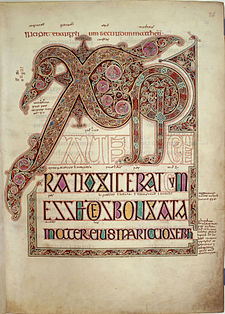
Back Angel-Saksers Afrikaans Angelsachsen ALS أنجلوسكسونيون Arabic انجلو ساكسون ARZ Anglosaxones AST Anqlo-sakslar Azerbaijani آنقلوساکسون AZB Англасаксы Byelorussian Англосаксонци Bulgarian অ্যাংলো-স্যাক্সন Bengali/Bangla

| This article is part of the series: |
| Anglo-Saxon society and culture |
|---|
 |
| People |
| Language |
| Material culture |
| Power and organization |
| Religion |
The Anglo-Saxons, in some contexts simply called Saxons or the English, were a cultural group who spoke Old English and inhabited much of what is now England and south-eastern Scotland in the Early Middle Ages. They traced their origins to Germanic settlers who became one of the most important cultural groups in Britain by the 5th century. The Anglo-Saxon period in Britain is considered to have started by about 450 and ended in 1066, with the Norman Conquest.[1] Although the details of their early settlement and political development are not clear, by the 8th century a single Anglo-Saxon cultural identity which was generally called Englisc had developed out of the interaction of these settlers with the pre-existing Romano-British culture. By 1066, most of the people of what is now England spoke Old English, and were considered English. Viking and Norman invasions changed the politics and culture of England significantly, but the overarching Anglo-Saxon identity evolved and remained dominant even after the Norman Conquest.[2] Late Anglo-Saxon political structures and language are the direct predecessors of the high medieval Kingdom of England and the Middle English language. Although the modern English language owes less than 26% of its words to Old English, this includes the vast majority of everyday words.[3]
In the early 8th century, the earliest detailed account of Anglo-Saxon origins was given by Bede (d. 735), suggesting that they were long divided into smaller regional kingdoms, each with differing accounts of their continental origins. As a collective term, the compound term Anglo-Saxon, commonly used by modern historians for the period before 1066, first appears in Bede's time, but it was probably not widely used until modern times.[4] Bede was one of the first writers to prefer "Angles" (or English) as the collective term, and this eventually became dominant. Bede, like other authors, also continued to use the collective term "Saxons", especially when referring to the earliest periods of settlement. Roman and British writers of the 3rd to 6th century had described those earliest Saxons as North Sea raiders, and mercenaries. Later sources such as Bede believed these early raiders came from the region they called "Old Saxony", in what is now northern Germany, which in their own time had become well-known as a region resisting the spread of Christianity and Frankish rule. According to this account, the English (Angle) migrants came from a country neighbouring those Saxons.
Anglo-Saxon material culture can be seen in architecture, dress styles, illuminated texts, metalwork and other art. Behind the symbolic nature of these cultural emblems, there are strong elements of tribal and lordship ties. The elite declared themselves kings who developed burhs (fortifications and fortified settlements), and identified their roles and peoples in Biblical terms. Above all, as archaeologist Helena Hamerow has observed, "local and extended kin groups remained...the essential unit of production throughout the Anglo-Saxon period."[5]
- ^ Higham et al. 2013.
- ^ Higham & Ryan 2013, pp. 7–19.
- ^ Williams, Joseph M. (1986). Origins of the English Language: A Social and Linguistic History. Simon and Schuster. ISBN 978-0-02-934470-5.
- ^ Higham & Ryan 2013, p. 7.
- ^ Hamerow 2012, p. 166.